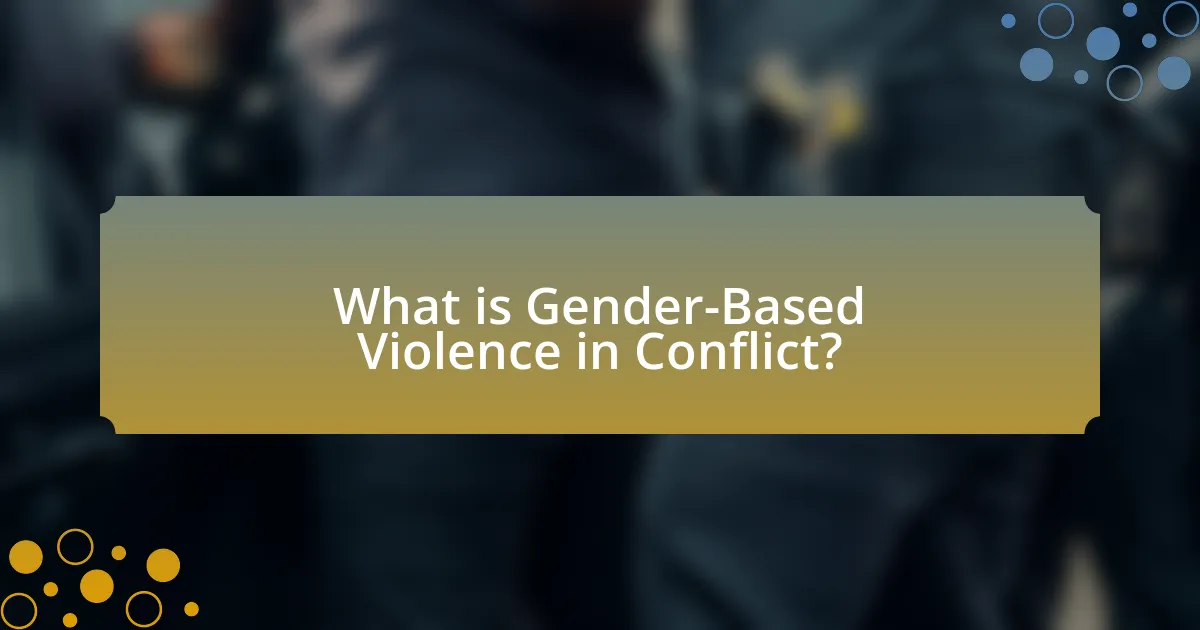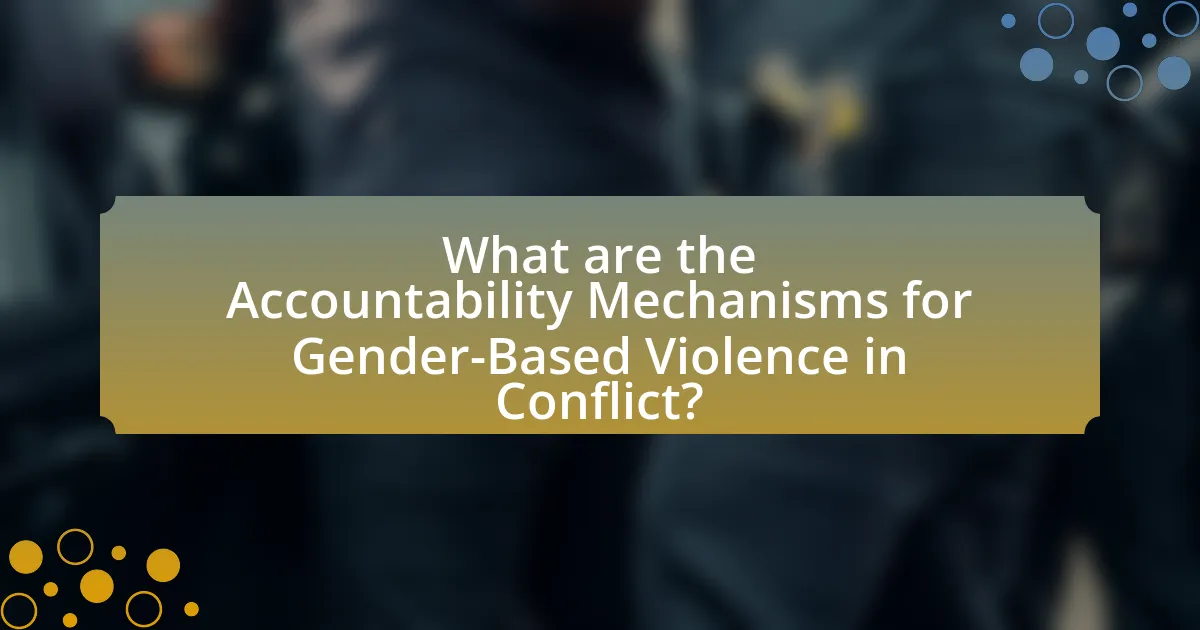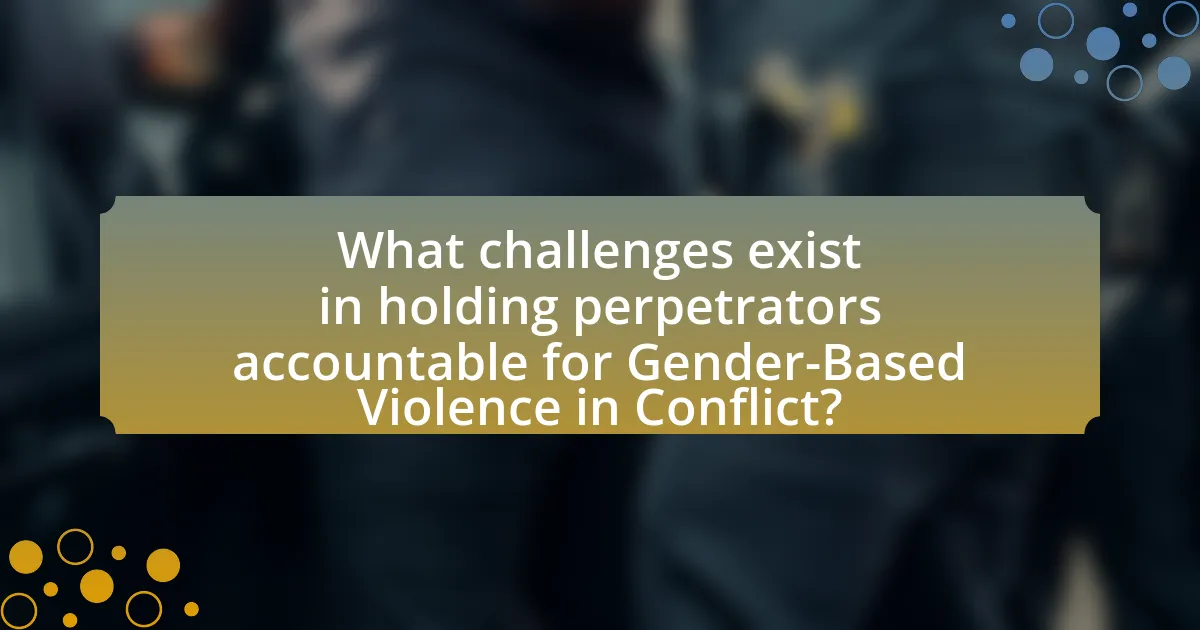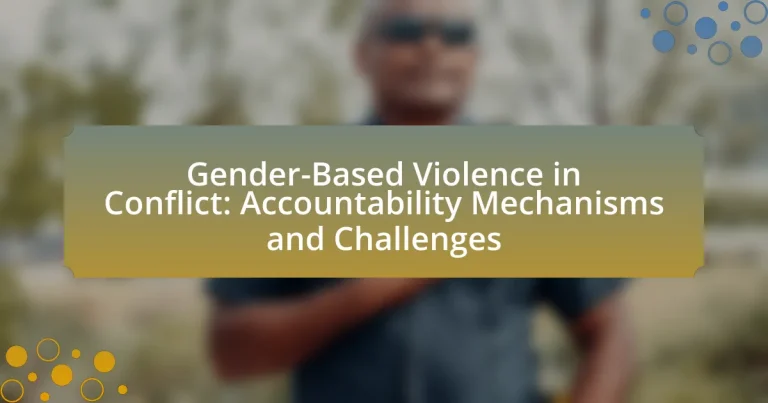Gender-Based Violence in Conflict refers to harmful acts directed at individuals based on their gender during armed conflicts, disproportionately affecting women and girls. This violence includes sexual violence, domestic abuse, trafficking, and exploitation, often used as a tactic of war to destabilize communities. The article examines the definitions, forms, and impacts of Gender-Based Violence, emphasizing the urgent need for accountability mechanisms such as international tribunals and national courts. It also discusses the challenges in prosecuting perpetrators, barriers to reporting, and the role of cultural attitudes and systemic issues in perpetuating this violence. Finally, it highlights practical steps and best practices to enhance accountability and support survivors in conflict settings.

What is Gender-Based Violence in Conflict?
Gender-Based Violence in Conflict refers to harmful acts directed at individuals based on their gender, occurring in the context of armed conflict. This violence can manifest as sexual violence, domestic abuse, trafficking, and other forms of exploitation, often targeting women and girls disproportionately. According to the United Nations, during conflicts, sexual violence is frequently used as a tactic of war to humiliate, control, and destabilize communities, with reports indicating that up to 50% of women in conflict zones may experience sexual violence. This highlights the urgent need for accountability mechanisms to address and prevent such violence in conflict settings.
How is Gender-Based Violence defined in the context of conflict?
Gender-Based Violence (GBV) in the context of conflict is defined as acts of violence directed at individuals based on their gender, which are exacerbated during armed conflicts. This includes sexual violence, such as rape and sexual slavery, as well as physical and psychological harm, often used as a tactic of war to humiliate, control, or displace communities. The United Nations has documented that in conflict zones, women and girls are disproportionately affected, with reports indicating that up to 50% of women in conflict-affected areas may experience sexual violence. This definition is supported by various international legal frameworks, including the Geneva Conventions and the Rome Statute of the International Criminal Court, which recognize such acts as war crimes and crimes against humanity.
What are the different forms of Gender-Based Violence experienced during conflicts?
Different forms of Gender-Based Violence (GBV) experienced during conflicts include sexual violence, human trafficking, forced prostitution, and domestic violence. Sexual violence, often used as a weapon of war, can manifest as rape, sexual slavery, and forced sterilization, impacting both women and men. Human trafficking and forced prostitution frequently occur in conflict zones, where vulnerable populations are exploited for sexual and labor purposes. Domestic violence tends to escalate during conflicts due to increased stress and breakdown of social structures. According to the United Nations, conflicts exacerbate existing inequalities, leading to heightened risks of GBV, with reports indicating that up to 50% of women in conflict-affected areas may experience sexual violence.
How does the context of conflict exacerbate Gender-Based Violence?
The context of conflict exacerbates Gender-Based Violence (GBV) by creating an environment where social norms break down, and law enforcement is weakened. During conflicts, armed groups often exploit the chaos to perpetrate violence against women and girls, viewing them as targets for sexual violence, trafficking, and exploitation. For instance, the United Nations has reported that in conflict zones, such as the Democratic Republic of the Congo, sexual violence is used as a weapon of war, with estimates suggesting that over 200,000 women have been raped since the conflict began in the late 1990s. Additionally, the breakdown of community structures and the displacement of populations lead to increased vulnerability, as women and girls face heightened risks of violence in refugee camps and during migration. These factors collectively contribute to a significant rise in GBV during conflicts, highlighting the urgent need for targeted interventions and accountability mechanisms.
Why is it important to address Gender-Based Violence in conflict situations?
Addressing Gender-Based Violence (GBV) in conflict situations is crucial because it directly impacts the safety, dignity, and health of individuals, particularly women and girls. In conflict zones, GBV often escalates due to the breakdown of law and order, leading to increased incidents of sexual violence, exploitation, and abuse. According to the United Nations, during conflicts, the risk of sexual violence can increase by up to 50 times compared to peacetime. Furthermore, addressing GBV is essential for the overall stability and recovery of communities, as it affects social cohesion and hinders post-conflict reconstruction efforts. Failure to address GBV can perpetuate cycles of violence and trauma, undermining peacebuilding initiatives and the rule of law.
What are the short-term and long-term impacts of Gender-Based Violence on individuals and communities?
Gender-Based Violence (GBV) has significant short-term and long-term impacts on individuals and communities. In the short term, individuals may experience physical injuries, psychological trauma, and social stigma, which can lead to immediate health issues and isolation from support networks. For instance, survivors often face mental health challenges such as anxiety and depression, with studies indicating that up to 50% of women who experience GBV report symptoms of post-traumatic stress disorder (PTSD).
In the long term, the impacts of GBV extend to chronic health problems, economic instability, and intergenerational trauma within communities. Survivors may struggle with long-lasting psychological effects, leading to decreased productivity and increased healthcare costs. Communities suffer as well, facing disruptions in social cohesion and economic development; research shows that areas with high rates of GBV often experience lower levels of community trust and participation, which can hinder recovery and growth. Thus, the ramifications of GBV are profound and multifaceted, affecting both individual well-being and community resilience.
How does Gender-Based Violence affect peace and security in conflict zones?
Gender-Based Violence (GBV) significantly undermines peace and security in conflict zones by exacerbating social instability and perpetuating cycles of violence. In conflict settings, GBV often becomes a weapon of war, used to intimidate, control, and demoralize communities, which can lead to increased tensions and hinder peace negotiations. For instance, the United Nations reports that in many conflicts, sexual violence is systematically employed to achieve military objectives, thereby destabilizing societal structures and eroding trust among community members. Furthermore, the prevalence of GBV can lead to long-term psychological trauma, which affects not only the victims but also their families and communities, ultimately impeding recovery and reconciliation efforts. This correlation between GBV and insecurity is evident in various conflict-affected regions, where high rates of sexual violence correlate with prolonged instability and hindered peace processes.

What are the Accountability Mechanisms for Gender-Based Violence in Conflict?
Accountability mechanisms for gender-based violence in conflict include international criminal tribunals, national courts, and truth commissions. International criminal tribunals, such as the International Criminal Court, prosecute individuals for war crimes, including sexual violence, as seen in the cases from the Rwandan Genocide and the Yugoslav Wars. National courts can also hold perpetrators accountable, although their effectiveness often depends on the legal framework and political will within the country. Truth commissions, like those established in South Africa, provide a platform for victims to share their experiences and seek justice, contributing to societal acknowledgment of the violence. These mechanisms aim to ensure that perpetrators are held accountable and that victims receive recognition and reparations.
How do international laws and conventions address Gender-Based Violence in conflict?
International laws and conventions address Gender-Based Violence (GBV) in conflict primarily through frameworks such as the Geneva Conventions, the Convention on the Elimination of All Forms of Discrimination Against Women (CEDAW), and the Rome Statute of the International Criminal Court. These legal instruments explicitly recognize GBV as a violation of human rights and a war crime, thereby obligating states to prevent, prosecute, and punish such acts. For instance, Article 27 of the Fourth Geneva Convention mandates the protection of women against violence, while the Rome Statute categorizes rape and sexual slavery as crimes against humanity. These provisions establish a legal basis for accountability and provide mechanisms for victims to seek justice, reinforcing the international community’s commitment to addressing GBV in conflict situations.
What role do the Geneva Conventions play in protecting victims of Gender-Based Violence?
The Geneva Conventions play a crucial role in protecting victims of Gender-Based Violence (GBV) during armed conflicts by establishing legal standards that prohibit such violence and mandate the protection of individuals. Specifically, Common Article 3 of the Geneva Conventions prohibits violence to life and person, including cruel treatment and torture, which encompasses acts of GBV. Furthermore, the Fourth Geneva Convention emphasizes the protection of civilians, including women and children, from violence, ensuring that parties to a conflict must take all feasible precautions to prevent GBV. These conventions are reinforced by additional protocols and international humanitarian law, which recognize sexual violence as a grave breach and a war crime, thereby holding perpetrators accountable. The International Criminal Court and various tribunals have cited the Geneva Conventions in prosecuting cases of sexual violence, demonstrating their effectiveness in providing a legal framework for the protection of victims.
How effective are international tribunals in prosecuting Gender-Based Violence cases?
International tribunals are moderately effective in prosecuting Gender-Based Violence (GBV) cases, as evidenced by their ability to establish legal precedents and hold perpetrators accountable. For instance, the International Criminal Tribunal for the former Yugoslavia (ICTY) successfully prosecuted cases of sexual violence, leading to landmark rulings that recognized rape as a war crime and a crime against humanity. Additionally, the International Criminal Court (ICC) has included GBV in its mandate, with cases such as the prosecution of Jean-Pierre Bemba for crimes of sexual violence in the Central African Republic highlighting its commitment to addressing GBV. However, challenges remain, including limited jurisdiction, political interference, and difficulties in gathering evidence, which can hinder the effectiveness of these tribunals in achieving justice for victims of GBV.
What national mechanisms exist for accountability regarding Gender-Based Violence?
National mechanisms for accountability regarding Gender-Based Violence (GBV) include legal frameworks, specialized law enforcement units, and judicial processes designed to address and prosecute GBV cases. For instance, many countries have enacted specific laws that criminalize various forms of GBV, such as domestic violence and sexual assault, providing a legal basis for prosecution. Additionally, some nations have established dedicated police units trained to handle GBV cases sensitively and effectively, ensuring that victims receive appropriate support and that perpetrators are held accountable. Furthermore, judicial systems often include specialized courts or procedures aimed at expediting GBV cases, thereby enhancing the likelihood of justice for victims. These mechanisms are supported by international guidelines and conventions, such as the Convention on the Elimination of All Forms of Discrimination Against Women (CEDAW), which encourage states to implement effective measures for accountability in GBV cases.
How do local legal systems handle cases of Gender-Based Violence in conflict settings?
Local legal systems often struggle to effectively handle cases of Gender-Based Violence (GBV) in conflict settings due to a combination of weakened judicial structures, lack of resources, and prevailing social norms that stigmatize victims. In many conflict-affected areas, legal frameworks may be inadequate or not enforced, leading to impunity for perpetrators. For instance, a study by the United Nations indicates that in some regions, less than 10% of GBV cases are reported to authorities, reflecting a significant gap in legal accountability. Additionally, cultural barriers often prevent survivors from seeking justice, as societal attitudes may blame victims rather than hold offenders accountable. This systemic failure highlights the urgent need for reforms and support mechanisms to ensure that local legal systems can effectively address and prosecute cases of GBV in conflict settings.
What role do non-governmental organizations play in promoting accountability?
Non-governmental organizations (NGOs) play a crucial role in promoting accountability by advocating for the rights of victims and monitoring the actions of governments and institutions. NGOs often provide legal assistance, raise awareness about gender-based violence, and document cases of abuse, which helps to hold perpetrators accountable. For instance, organizations like Amnesty International and Human Rights Watch have reported extensively on gender-based violence in conflict zones, influencing policy changes and legal reforms. Their reports often serve as evidence in international courts, reinforcing the need for accountability and justice for victims.

What challenges exist in holding perpetrators accountable for Gender-Based Violence in Conflict?
Holding perpetrators accountable for Gender-Based Violence in Conflict faces significant challenges, including lack of legal frameworks, insufficient evidence collection, and political instability. Many conflict-affected regions lack comprehensive laws that specifically address gender-based violence, which complicates prosecution efforts. Furthermore, the chaotic environment during and after conflicts often hinders the collection of reliable evidence, making it difficult to build strong cases against perpetrators. Political instability can also lead to a lack of will among authorities to pursue justice, as they may prioritize other issues or be complicit in the violence. According to the United Nations, in many post-conflict societies, only a small percentage of gender-based violence cases are prosecuted, highlighting the systemic barriers to accountability.
What are the barriers to reporting Gender-Based Violence in conflict zones?
Barriers to reporting Gender-Based Violence in conflict zones include fear of retaliation, lack of trust in authorities, stigma, and inadequate access to support services. Victims often fear that reporting will lead to further violence from perpetrators or their communities, as evidenced by studies indicating that 70% of survivors in conflict areas cite fear of retaliation as a primary reason for not reporting incidents. Additionally, many victims lack confidence in the ability of local authorities to provide protection or justice, which is supported by reports showing that only 20% of survivors believe that reporting will lead to a positive outcome. Stigmatization of victims further discourages reporting, as cultural norms in many conflict-affected areas often blame survivors rather than perpetrators. Lastly, limited access to healthcare and legal services in conflict zones exacerbates the issue, with humanitarian organizations noting that only 30% of survivors receive the necessary medical care and support.
How do cultural attitudes impact the reporting of Gender-Based Violence?
Cultural attitudes significantly influence the reporting of Gender-Based Violence (GBV) by shaping societal norms and perceptions surrounding such incidents. In many cultures, stigma and shame associated with being a victim can deter individuals from coming forward, as they fear social ostracism or victim-blaming. For instance, a study by the World Health Organization found that in societies where traditional gender roles are strongly upheld, victims are less likely to report incidents due to fear of not being believed or facing repercussions from their community. Additionally, cultural beliefs may prioritize family honor over individual rights, leading to a preference for resolving issues privately rather than through formal reporting channels. This interplay of cultural attitudes creates barriers that hinder accurate reporting and accountability for GBV.
What risks do survivors face when seeking justice for Gender-Based Violence?
Survivors of Gender-Based Violence face multiple risks when seeking justice, including re-traumatization, social stigma, and potential retaliation from perpetrators. Re-traumatization occurs as survivors recount their experiences during legal proceedings, which can exacerbate psychological distress. Social stigma often leads to isolation and discrimination, as survivors may be blamed for the violence they experienced. Additionally, there is a significant risk of retaliation, where perpetrators may threaten or harm survivors to discourage them from pursuing legal action. According to a study by the World Health Organization, many survivors report fear of further violence as a primary barrier to seeking justice, highlighting the pervasive risks involved in the process.
How do systemic issues hinder accountability for Gender-Based Violence?
Systemic issues hinder accountability for Gender-Based Violence (GBV) by creating barriers in legal, social, and institutional frameworks. These barriers include inadequate legal protections, lack of resources for enforcement, and societal stigma that discourages reporting. For instance, a study by the World Health Organization indicates that in many countries, only 10% of women who experience violence seek help due to fear of stigma or disbelief from authorities. Additionally, systemic corruption within law enforcement can lead to a lack of investigation and prosecution of GBV cases, further perpetuating a culture of impunity. These factors collectively undermine the effectiveness of accountability mechanisms, allowing GBV to persist unchallenged.
What role does impunity play in perpetuating Gender-Based Violence in conflict?
Impunity significantly contributes to the perpetuation of Gender-Based Violence (GBV) in conflict by allowing perpetrators to act without fear of consequences. In conflict zones, the lack of accountability mechanisms often leads to a culture where violence against women is normalized and unpunished. For instance, a report by the United Nations indicates that in many armed conflicts, less than 1% of sexual violence cases result in prosecution, which emboldens offenders and discourages victims from seeking justice. This absence of legal repercussions not only perpetuates the cycle of violence but also undermines the rule of law and the protection of human rights, further entrenching gender inequalities in post-conflict societies.
How do resource limitations affect the effectiveness of accountability mechanisms?
Resource limitations significantly hinder the effectiveness of accountability mechanisms in addressing gender-based violence in conflict. Limited financial, human, and technical resources restrict the capacity of institutions to investigate, prosecute, and monitor cases effectively. For instance, a lack of trained personnel can lead to inadequate investigations, resulting in low conviction rates and a failure to hold perpetrators accountable. Additionally, insufficient funding can limit outreach efforts, preventing survivors from accessing necessary support services and legal recourse. Research by the United Nations indicates that in conflict-affected regions, only 10% of reported cases of gender-based violence lead to prosecution, highlighting the direct correlation between resource availability and accountability outcomes.
What practical steps can be taken to improve accountability for Gender-Based Violence in conflict?
To improve accountability for Gender-Based Violence in conflict, establishing robust legal frameworks and ensuring their enforcement is essential. Countries must adopt and implement laws that specifically criminalize gender-based violence, aligning with international standards such as the Convention on the Elimination of All Forms of Discrimination Against Women (CEDAW). Additionally, training law enforcement and judicial personnel on gender sensitivity and the complexities of gender-based violence can enhance the effectiveness of legal responses.
Furthermore, creating independent monitoring bodies to oversee investigations and prosecutions can ensure transparency and accountability. For instance, the establishment of the International Criminal Court (ICC) has provided a mechanism for prosecuting war crimes, including sexual violence, thereby reinforcing accountability.
Engaging local communities in awareness campaigns can also empower victims to report incidents and seek justice, as evidenced by programs in conflict-affected regions that have successfully increased reporting rates. Lastly, ensuring that victims have access to support services, including legal aid and psychological support, is crucial for fostering an environment where accountability can thrive.
How can community engagement enhance reporting and accountability efforts?
Community engagement enhances reporting and accountability efforts by fostering trust and collaboration between affected communities and accountability mechanisms. When communities actively participate in reporting processes, they provide valuable insights and context that improve the accuracy and relevance of data collected on gender-based violence in conflict. For instance, studies show that community-led initiatives can increase reporting rates by up to 50%, as individuals feel safer and more empowered to share their experiences. Furthermore, engaged communities are more likely to hold authorities accountable, as they can collectively advocate for justice and transparency, thereby reinforcing the effectiveness of accountability mechanisms.
What best practices can be implemented to support survivors of Gender-Based Violence?
To support survivors of Gender-Based Violence, implementing trauma-informed care practices is essential. Trauma-informed care recognizes the impact of trauma on individuals and emphasizes safety, trustworthiness, and empowerment. Research indicates that such approaches can significantly improve the mental health outcomes of survivors, as evidenced by a study published in the Journal of Interpersonal Violence, which found that trauma-informed services led to a 50% reduction in symptoms of PTSD among participants. Additionally, providing access to legal assistance and advocacy services is crucial, as survivors often face barriers in navigating the legal system. A report by the World Health Organization highlights that legal support can increase the likelihood of survivors seeking justice and receiving necessary resources. Furthermore, establishing community-based support networks fosters a sense of belonging and reduces isolation, which is vital for recovery. The National Domestic Violence Hotline reports that survivors who engage with community support services experience higher levels of emotional well-being and resilience.


